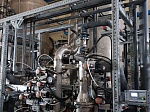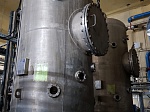06.09.2019
INFORMATION AND PUBLIC RELATIONS DEPARTMENT OF LENINGRAD NPP
The Leningrad NPP-2: the first cubic meter of chemically demineralized water has been produced at the innovative 2nd VVER-1200 power block
The water treatment facility required to product chemically demineralized water for the 2nd VVER-1200 power block under construction has been successfully tested at the Leningrad NPP-2 site.
According to the Leningrad NPP-2 chemical hall team, the water treatment facility will be launched until the end of September. The water from it will be required for the circulation cleaning of the primary circuit reactor facility at the 2nd power block under construction.
During the production run, the water will be used to fill in the block’s primary and secondary circuits connecting the primary equipment of the reactor and the turbine facilities for boosting, airing, cooling, deactivation, regeneration, etc.
‘As we are chemists, our primary consideration with regard to the power block’s safety is water treatment. The source natural water coming to us from the Gulf of Finland has lots of impurities. The water treatment facility cleans it from seaweed, sand, bacteria, and saline, which gives us almost perfect substance. If we use this water, we can avoid the construction materials corrosion and any sediments at the equipment and pipeline surfaces, which means their life span can be extended without compromising their heat-transfer properties. High quality reclaimed water facilitates continuity of the process loop safety barriers’, Sergey Dmitriev, the head of the chemical hall at the Leningrad NPP, said.
‘The water treatment facility will provide 90 cubic meters of chemically demineralized water per hour. This is comparable to a pond with the dimensions of 5 x 8 x 2 meters filled with perfectly clean water every hour’, Andrey Stetsiuk, the lead engineer of the chemical hall, said.
Reference:
Compared to the traditional VVER-1000 power blocks, the design for the 3+ generation Leningrad NPP power block boasts a number of improvements that improve its economic parameters and safety. For instance, the electric capacity of the reactor assembly is increased by 20%, from 1000 to 1200 megawatt; the core equipment lifetime is doubled from 30 to 60 years. At the same time, the power block adheres to the cutting-edge global industry standards with regard to nuclear safety.
The Leningrad NPP is the country’s first plant with RBMK-1000 reactors (uranium-graphite circuit-type reactor running on thermal neutrons). The decision that marked its construction was taken in September 1966 by a resolution of the Central Committee of the Communist Party of the USSR and the Council of Ministers No. 800-252. According to that document, the Leningrad NPP was supposed to become a core in a network of nuclear power plants with RBMK-1000 reactors that were supposed to produce a substantial share of electric power. The construction of the Leningrad NPP was going well, and by 1973 the first power block was fully erected. On December 23, 1973, following stable 72-hours’ operation at the capacity of 150 megawatt, the State Commission signed the acceptance certificate stating that the first power block of the Leningrad nuclear power plant is commissioned for pilot production.



 career
career Innovations
Innovations Projects
Projects INTERNATIONAL BUSINESS
INTERNATIONAL BUSINESS